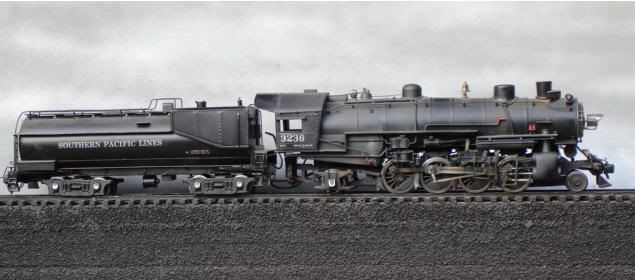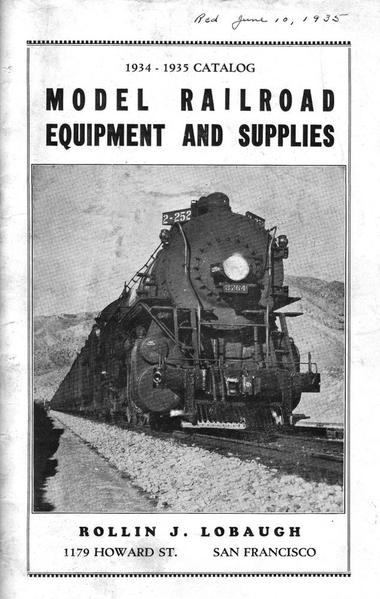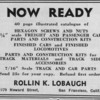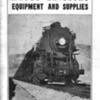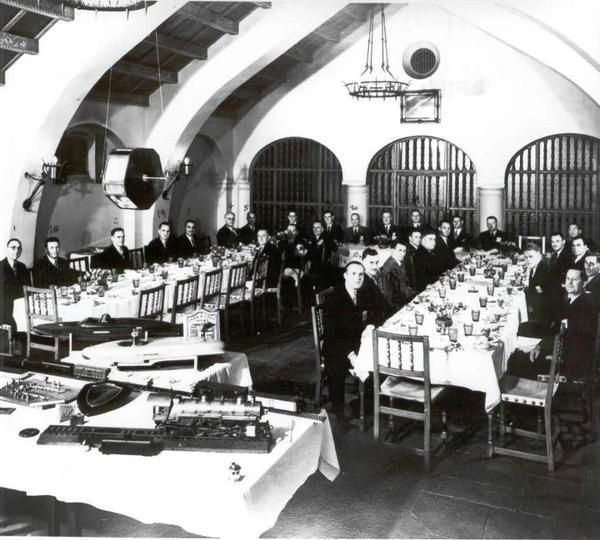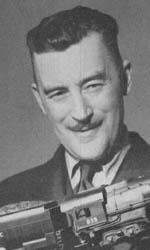Can any members give me information on the company that made Lobaugh trains? Thnx! Dick K.
Replies sorted oldest to newest
Dick,
I know some of the 2-rail gurus know.
How can i resist? What would you like to know? Roughly 1937-1955, originally producing O Scale only when the screw and bolt business slowed down, so he wouldn't have to lay off good people. Mostly steam, but some freight cars.
Bob2, that's a beautiful 2-8-2, would love to have one.
Ron
They were in business from the early 1930s. They sold parts and car kits in O scale and 7/16" scale (for 2-1/8" Standard Gauge track).
Here is an ad from May 1934:
And from February 1935:
And from the cover of their 1934-35 catalog:
I think that catalog was 40 pages...
Hope this helps with some of the history.
ARNO
Attachments
Lobaugh stuff regularly shows up on ebay. The boxcars and reefers resemble the old Athearn stuff but Lobaugh made his own parts so they are a bit different, the boxcar roofs are two piece and the frames include draft gear for instance. I had quite a few Lobaugh runner cars when I was working in O scale, they were sturdy and felt authentic since they were actually built in the era I was modeling.They don't have the exaggerated detail of new Atlas or Lionel cars but their thin metal construction makes them seem more realistic......DaveB
Not totally sure, but I believe locomotived before 1937 were produced by others. The Mikado, an SP Mountain, and the 17/64 SP switcher appeared in 1937. Woody Mathews can help with pre- 1937 history.
So did they make you move this out of the 3-rail section? Too bad, because we were just about to introduce those folks to some obscure O Scale history, some of it 3-rail.
You probably already know this but I am a serious Lobaugh collector. I have every single model they produced except the Rock Island Mikado, the Suburban Tank, and possibly a ten-wheeler I know nothing about. We are pretty sure the 1941 GS-3 never got off the drawing boards, but I built my own just in case.
I enjoyed the story of when Lobaugh paid a visit to keyrouttaken's(Ken Shattock) grandfather's layout (Victor Shattock)in his basement.
His father machined all of the parts for all of his live steam engines and cars and ran them in the basement of their home.
They were both extraordinary model builders.
Bob,
You will be interested to know that I am currently reworking the drive of a Lobaugh SP Cab Forward that was handed to me at the Strasburg O meet a couple of weeks ago. This model has been through a lot of bad handling and poor "repairs" over the years.
I am machining some new parts for it. The model has a Bueller can motor that was held in the model with a piece of twisted music wire! I fabricated a brass motor mount yesterday and the motor is now properly attached to the frame. There is a lot more to be done but I think I can get this loco up and running shortly.
The owner also has what looks to be a another almost complete cab forward kit un-assembled. He want me to assemble the mechanism for him. To see two of these rare models at one time was quite an experience. I don't believe these models were ever cataloged. The owner handed me a set of Lobaugh Cab Forward drawings dated October and November 1941. This probably explains why there were very few produced.
For myself, I am currently building a Lobaugh USRA Pacific with some modifications. Instead of using the 16 spoke Lobaugh drivers, I have machined a set of 17 spoke drivers from very nice brass sand castings that were in my stash of driver castings.
Joe Foehrkolb
Not totally sure, but I believe locomotived before 1937 were produced by others. The Mikado, an SP Mountain, and the 17/64 SP switcher appeared in 1937. Woody Mathews can help with pre- 1937 history.
So did they make you move this out of the 3-rail section? Too bad, because we were just about to introduce those folks to some obscure O Scale history, some of it 3-rail.
You probably already know this but I am a serious Lobaugh collector. I have every single model they produced except the Rock Island Mikado, the Suburban Tank, and possibly a ten-wheeler I know nothing about. We are pretty sure the 1941 GS-3 never got off the drawing boards, but I built my own just in case.
Bob was the Suburban tank the CNJ or NYC one? Kit or partially RTR (I know little about Lobaugh so forgive the kit/RTR question)
Several years ago there was a CNJ 4-6-4t kit on ebay that I should have bought and had assembled.
"I am a serious Lobaugh collector. I have every single model they produced except the Rock Island Mikado, the Suburban Tank, and possibly a ten-wheeler"
Did Lobaugh ever make an outside braced auto car? I had this model years ago, it had a Lobaugh underframe but I don't know if it was a kit or scratch built. ...DaveB
Attachments
Yes. See page 25 of the 1940 catalog. The 1940 catalog is the most important, and the 1941 supplement shows the Gs and Cab Forward.
The Suburban Tank used parts from the 4-4-0 and Cab Forward, and had no prototype. It may have used the Pacific frame, with smallr drivers. Designed to use up leftover parts in the 1950s. That is all opinion.
On the Cab Forward - I have two, and have seen maybe four others. I have the only original Lobaugh tender I have ever seen, plus an extra underframe. Jan Lorenzen and I felt that there might be a dozen or so Lobaugh Cab Forwards in existence. The drawings are dated December 7, 1941, and you can bet all production stopped the day afer that.
While I doubt Joe's model is one I had anything to do with, I usually attach motors with either aircraft safety wire or hose clamps. That way I can completely embed them in rubber sheets if I want.
Let me ask again - why did this thread get moved here - to keep the 3-rail scalers from new stuff? Most of you have seen all my photos, so I am less motivated to bore you with them again.
Well I think this is always a good subject,any one for Scalecraft,Mini-I-Scale ETC cTr....(Choose the Right)
Well I think this is always a good subject,any one for Scalecraft,Mini-I-Scale ETC cTr....(Choose the Right)
Absolutely. I am always interested in the history of the hobby and O Scale in particular.
Let me ask again - why did this thread get moved here - to keep the 3-rail scalers from new stuff? Most of you have seen all my photos, so I am less motivated to bore you with them again.
Bob,
Not sure, but I'm guessing maybe because of my post and someone not knowing Lobaugh made 3-rail engines.
Bob/Joe...do ya'll have any videos showing how you make spoked drivers? I saw one Youtube video of someone making drivers on a CNC machine, pretty cool stuff but I couldn't tell what scale it was (bigger than O I think).
3D printed masters would be the norm these days I would think, do cast wheels perform as well as machined wheels?
While I have a mini-lathe I don't have a mini-mill, of course I could probably get one if I stopped buying trains for a month!
Bob, What size drivers do you need? There are sources available to supply a pretty good selection of wheel centers, unless you want to be able to say "I made them myself".
My grandfather was very good friends with Rollin J. Lobaugh of O-gauge fame, for it was his company in San Francisco that produced the BRASS rail, rail joiners, tie plates and spikes for my grandfather's live steam basement railroad!
Around 1930, the Golden Gate Model Engineers Guild in SF consisted of electric model railroaders, live steam enthusiasts, model plane, boat and model race car buffs. Rollin J. Lobaugh and my grandfather both belonged to the Guild! About 1933, the electric RR buffs split off and founded the Eastbay Model Engineers Society led by Walter I. Brown...
In 1936, my grandfather, Vic Shattock, took his followers and split off from the Guild and created the Golden Gate Live Steamers; the oldest live steam club in the U.S. today!
My Uncle Ron, Vic's oldest son, also belonged to the Guild. Vic and Ron were known as "Big Smoke" and "Little Smoke" Shattock to the other Guild members !
The ATTACHED photo shows one of the many monthly dinner meetings of the Guild.
Now look carefully: In the second row from the right, 2nd person from the front, is "Rollin J. Lobaugh" (with a #10 behind his head)...
In the far right row, 3rd person from front (leaning way forward) is "Ronald 'Little Smoke' Shattock" ...... In the same row, 2nd from front (right next to Ron) is Victor "Big Smoke" Shattock.... So, we have a steam railway builder and the "rail producer" having dinner together. How 'bout that ?
------------------------------------
More about Rollin J. Lobaugh:
Rollin Lobaugh was one of the pillars of the O scale community. He started his model business in 1931. By 1941 Lobaugh offered an astounding 11 locomotive kits ranging from a 4-4-0 to a 4-6-6-4 Challenger and just about every wheel arrangement in between. Lobaugh also offered over 120 freight car kits. Lobaugh offered a “Warrantee of Fine Craftsmanship: Any purchaser of Lobaugh equipment who is not satisfied will, upon return of the equipment within thirty days, receive a refund of the full purchase price, plus a refund of all transportation costs paid by the purchaser.” Mr. Lobaugh liked to boast that no one had ever taken him up on his offer. Compared to today’s imports many Lobaugh locomotives may seem crude, and they were in regard to fine details, but they were mechanical masterpieces. Many are still running today. Lobaugh produced models from 1931 through 1965, first under Mr Lobaugh himself and then under Earl Allison, the chief engineer and designer after Mr. Lobaugh’s death. Since then the Lobaugh line has passed through many hands over the years, getting split here and there. It currently is divided among three concerns, Locomotive Workshop, Trackside Specialties and Stevenson Preservation Lines. This last company` probably has the most extensive collection and has resurrected the Lobaugh SP Mikado kit. Rollin Lobaugh was elected to the O Scale Hall of Fame in 1995 at the O nationals in New Jersey. In 1996, he was enrolled in the Model Railroad Industry Association (MRIA) Hall of Fame. Though long gone, Lobaugh remains a pillar of the O scale community both in material presence and in spirit. |
Cheers to all you guys.
KRK
I enjoyed the story of when Lobaugh paid a visit to keyrouttaken's(Ken Shattock) grandfather's layout (Victor Shattock)in his basement.
His father machined all of the parts for all of his live steam engines and cars and ran them in the basement of their home.
They were both extraordinary model builders.
Attachments
Bob Delbridge.
I have never had to make a spoked driver center. There are plenty of rough driver castings out there to work with. Stevenson Preservation Lines currently offers quite a few castings and PSC also has a few. At large O meets like Chicago, you can usually find cast iron and brass driver center castings that are years old and have never been machined or that have been poorly machined and can be reworked. You just have to keep an eye out for them. I have machined many rough driver castings and that is a bit more work than converting 3 rail drivers that already have crankpins to 2 rail.
It is always nice to see a finished driver machined from a rough casting in the shop.
I believe there is a bucket load or two of driver castings lying around waiting to be machined. Keep your eyes open. If you need a certain size for a project, let me know, I may have them here. I just found three sets ( 3 Axles per set) of cast iron machined drivers with 17 spokes that measure out to about 79" and half are insulated for 2 rail. I think they are bored for 3/16" axles. I would part with two sets of them.
Joe Foehrkolb
Bob2,
From your description of your motor mounting method this model may have passed through your shop. The motor was attached witha piece of steel wire throug a small hole drilled in the bronze frame of the loco and tires across the top of the motor with a series of twists. Under the motor there was a piece of rubber material that looked like carpet padding. The motor has a brass pulley on its shaft with two grooves that held spring wire belts. The worm gear shaft had a piece of rubber hose on it that the spring belts ran on. Oddly the pulley on the motor was not fastened to the motor shaft and could hunt on the shaft as the motor ran. I fabricated a brass motor mount from 1/16" brass plate, drilled and tapped the shoulder of the motor pulley for a 6/32 set screw and machined a 3/8" diameter worm shaft pulley with grooves to hold the spring belt below the motor shaft pulley.
The rear frame was milled so that the rear gearbox assembly could sit with its shaft horizontal and is now coupled to the front driver mechanism with a combination brass sleeve and section of Toyota hose per your recommendations. Initial testin of the mechanism indicates that the model runs smoothly of a somewhat of a slow top speed. I may expriment with making a somewhat larger diameter motor pulley to increase the models to speed.
Lots of fun and something different from routine 3 rail to 2 rail conversions.
Joe Foehrkolb




